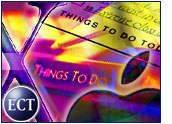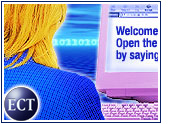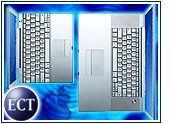
It used to be you couldn’t coax Apple Computer into breathing a word about enterprise-class computing. When you mentioned selling to the suits, Macintosh marketing folks would get fidgety and flip to the next PowerPoint slide. This was surprisingly true during the tenure of Gil Amelio, whose idea of enterprise strategy was the truly strange marriage of Macintosh and IBM’s AIX for Apple hardware. Under Amelio, Apple was sometimes insanely weird.
The company’s release of the Xserve was a surprising step in a new direction. Branded as merely an acquiescence to the unmet needs of creative types, the machine is actually a well-designed 1U rack server that has won approval from trade pubs that often dote on IBM and Hewlett-Packard. Xserve is really the first open acknowledgement that Apple must build enterprise-class equipment to survive. But the market is already shifting from 1U rack-mount servers to racks of computers-on-a-card, known as blade servers.
Apple can play the blade server game, too. It has the technology, and it has won some attention with Xserve. The only thing Apple doesn’t have is enterprise-class software that businesses want. Even that may be negotiable, though. In truth, an Apple blade server would be a pretty swell product.
It’s the Technology, Stupid
In terms of hardware, Apple has the right mix of sophistication and price to build a winning blade server system. There is a misapprehension that blade serving is all about commodity (read: really cheap) computing or open systems, both of which mean PCs and Linux to most people. But the roots of blade servers are really in the field of networking, not in the low-tech PC world of razor-thin. The standard rack-mount blade chassis, with its hot-pluggable processor cards, comes straight out of the routing and switching devices that Cisco Systems, Juniper Networks and their ilk have built for several years now. The blade is just one of several modules that, like the switching cards in a Cisco router, allow administrators to consolidate functions.
And consolidation is not about being cheap above all else. It’s about avoiding management complexity, and thereby saving on labor costs, by putting more and more relatively inexpensive microprocessor-based computers into a single device that’s easy to maintain. Estimates are that labor — including maintenance, scheduling backups and troubleshooting — can make up 70 percent of the cost of running an IT shop. Consolidation can cut staff requirements, theoretically, and what makes consolidation possible is not cheap chips or free software, but technology. That’s where Apple can shine.
With its engineering work on Xserve — things like the new Intrepid chipset and follow-on RAID storage — Apple has proved itself adept at trying to develop memory and input/output capabilities across an entire system that make up for individual areas where it lags, such as the relatively slow Motorola processors. It’s the same approach as in the networking world, where a well-designed chassis with a fast backplane ties together individual networking cards. (If you don’t believe me, take a look at what Cisco is doing to turn the commodity computing of newly acquired Linksys into a high-margin, soon-to-be overengineered product.)
Indeed, if you look at the blade servers from Sun Microsystems and IBM, you’ll see they’re all about thoughtful systems engineering, not just cheap Pentiums.
Special Sauce
Clever hardware Apple can do; it’s the software that’s the problem. Not that Apple’s Mac OS X is bad code, mind you. With its Unix underpinnings and its ease of use, the operating system can make a claim to being both reliable and extremely easy to manage — someday. The software currently doesn’t have the demonstrated “five 9’s” reliability of the enterprise computer players; for that, OS X probably needs a few more years, not to mention a few more powerful press releases.
However, even reliability can be finessed. The point of blade servers is that individual operating system “run times” are less important when you’re clustering many processors together. So, if a single OS X instance were to go down, it might not be a big deal.
What is more pressing for Apple is that it does not have the applications people want. It doesn’t have Windows, certainly, but it also doesn’t have SAP, Siebel or lots of shops running Oracle and DB2 databases to which it can point with pride.
Fortunately, this is not an insurmountable problem. Some of the work of blade servers will involve consolidation of existing IT infrastructure, such as servers running large CRM applications. But a lot of that mission-critical work will be the last thing moved off a mainframe or mid-range server. Much of a blade server’s applications will be so-called “green field” offerings — relatively new kinds of software, such as Web servers and Web services applications. This is a wide-open area in which Apple reasonably could enter a bid.
In It To Win It
There’s no reason Apple couldn’t put together a cost-effective blade server offering. It’s true that the company doesn’t have thousands of sales reps or generous vendor financing, like IBM’s Global Services unit. But it’s got to start somewhere. All of the companies in this market, including Sun, IBM and HP, are drawing from the same well of technology as Apple, including microprocessor architectures and Unix software of one flavor or another.
Apple can undercut some of these firms on price, if it can prove that it can save companies money on labor by bringing its classic ease of use to the job of running servers. And if Apple can make inroads into corporate accounts via Web serving and Web services, it may be able to win the attention of large software vendors such as SAP despite the small installed base of PowerPC systems. Here’s hoping the company doesn’t simply flip to the next slide.
Note: The opinions expressed by our columnists are their own and do not necessarily reflect the views of the E-Commerce Times or its management.























































Apple not only has the right technology, it already has the right
motherboard. Repackaging a powerbook is all that’s needed.
Blade servers are only going to take off when they can handle much more RAM than the current generation. There is a massive market for RAM+parallel processing-based decision-support.
Stephan
The biggest hole in Apple’s server offering is not a blade server, but ECC memory. I know several people
who would love to use a Macintosh server, but without the option of ECC memory, they end up buying Sun, IBM, or PC hardware instead. Even though memory problems are rare, they are sufficiently difficult to diagnose that it’s worth the extra cost to have reliable memory.
The article states that ‘[Mac OS] currently doesn’t have the demonstrated "five 9’s" reliability of the enterprise computer players.’
I’d like to know which version(s) of Windows do.